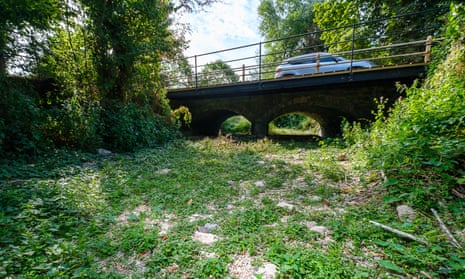The source of the Thames has dried up during the drought, with river experts saying it is the first time they have seen it happen while forecasters warn of further high temperatures to come.
The river’s source has shifted from its official start point outside Cirencester during the continuing dry weather and is now more than 5 miles (8km) downstream.
Dr Rob Collins, director of policy and science at the Rivers Trust, said: “Following the prolonged dry weather, the source of the Thames in Gloucestershire has dried up, with a weak flow now only just about discernible more than 5 miles downstream (at Somerford Keynes).
“Under our changing climate we can anticipate the frequency and severity of such periods of drought and water scarcity to intensify, with increasing competition for a dwindling resource and devastating impacts on aquatic life.”
The Met Office said on Thursday that the heatwave and dry weather show no signs of letting up, with little rain forecast for the next week and temperatures that could rise to the mid-30s.
The Met Office chief forecaster, Steve Willington, said: “Many areas of the UK, especially the south, will witness temperatures several degrees higher than average, but these values are likely to be well below the record-breaking temperatures we saw in mid-July.
“As the high pressure builds there is very little meaningful rain in the forecast, especially in those areas in the south of England, which experienced very dry conditions last month.”
Even as the source of the Thames shifts during the dry weather, Thames Water has not implemented restrictions on water use such as a hosepipe ban. Instead it is asking users to be judicious with their tap water, doing things such as turning off the tap while brushing their teeth. Government sources revealed on Wednesday they were frustrated that water companies were not putting hosepipe bans in place.
Thames Water has warned that a ban could be put in place. The supplier began the first stage of its “drought plan” in May but warned the next phase would be to implement a temporary use ban, including on hosepipes.
A spokesperson said: “The timing will depend on the amount of water used by our customers, which determines the speed at which reservoir storage declines, and the amount of flow in the rivers, which determines how much water we can take to refill them.”
Collins said water needed to be used more efficiently in homes and businesses, by implementing metering nationwide and reducing leakage in our supply networks.
He added: “Implementing nature-based solutions that hold water back – storing it and releasing it slowly to rivers when they most need it – [means] we can become more resilient to this changing climate, ensuring a sufficient future supply of water for both people and wildlife.”
Thames Water came under criticism on Wednesday for reportedly mothballing a £250m desalination plant launched 12 years ago to increase drinking supplies during long dry spells.
The Thames Water plant at Beckton, east London, opened in 2010 with plans to supply up to 1 million people during emergencies, but that ambition has been scaled back amid doubts as to when the facility can begin operating.
Despite July’s heatwave and the driest eight-month spell since 1976, the Beckton plant will not start supplying drinking water until next year at the earliest.
Statistics from the Met Office showed that July this year was the driest July for England since 1935, and the driest July on record for East Anglia, south-east and southern England.
The UK Centre for Ecology and Hydrology has shown how much of the country is at risk of drought. East Anglia and Kent are showing the most severe category, “extremely dry”, and other home counties and Devon are ranked as “severely dry”.
Cornwall, central England, north Wales, east Scotland and parts of the north-east have had a “moderately dry” six months but this could change if they continue to have below average rainfall.
This week, South East Water announced that Kent and Sussex would be under a hosepipe ban from the 12 August until further notice, with a £1,000 fine for those found flouting the rules. Last week, Southern Water said that Hampshire and the Isle of Wight would be under similar measures from Friday.









